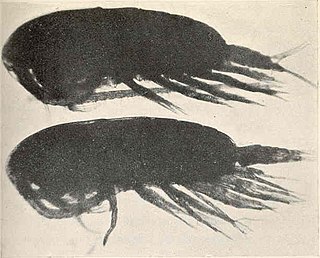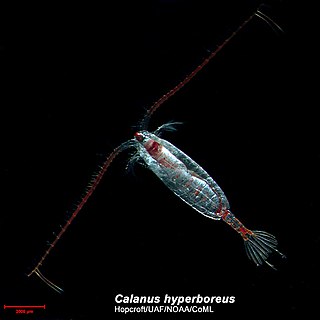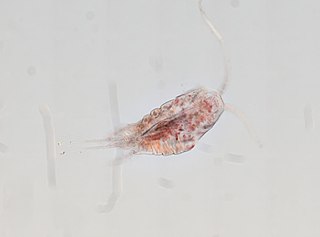
Copepods are a group of small crustaceans found in nearly every freshwater and saltwater habitat. Some species are planktonic, some are benthic, a number of species have parasitic phases, and some continental species may live in limnoterrestrial habitats and other wet terrestrial places, such as swamps, under leaf fall in wet forests, bogs, springs, ephemeral ponds, and puddles, damp moss, or water-filled recesses (phytotelmata) of plants such as bromeliads and pitcher plants. Many live underground in marine and freshwater caves, sinkholes, or stream beds. Copepods are sometimes used as biodiversity indicators.

Calanus finmarchicus is a species of copepods and a part of zooplankton, which is found in enormous amounts in the northern Atlantic Ocean.

Bettina Meyer is a German Antarctic researcher, best known for her work on the ecology and physiology of invertebrates in the pelagic zone. She is the head of the ecophysiology of pelagic key species working group at the Alfred Wegener Institute for Polar and Marine Research (AWI).

Calanus hyperboreus is a copepod found in the Arctic and northern Atlantic. It occurs from the surface to depths of 5,000 metres (16,000 ft).
Calanus glacialis is an Arctic copepod found in the northwestern Atlantic, adjoining waters, and the northwestern Pacific and its nearby waters. It ranges from sea level to 1,800 metres (5,900 ft) in depth. Females generally range from about 3.6 to 5.5 millimetres in length, and males generally range from about 3.9 to 5.4 millimetres in length.
Calanus helgolandicus is a copepod found in the Atlantic, from the North Sea south to the western coast of Africa. The female has an average size of about 2.9 millimetres (0.11 in) and the male has an average size of about 2.7 millimetres (0.11 in).

Calanoides acutus is a copepod found in Antarctica and the surrounding waters.
Metridia longa is a copepod found in the Arctic, the north Atlantic, the Pacific, and surrounding waters. The female has an average length of about 4.2 millimetres (0.17 in), and the males have an average length of about 3.5 millimetres (0.14 in).
Neocalanus plumchrus is a large copepod found in the Pacific and Arctic Oceans. It was described in 1921 by Marukawa. N. flemingeri used to be placed in this species, likely as a form, until it was split in 1988 by Charles B. Miller.
Neocalanus cristatus is a species of copepod found primarily in the northern Pacific.
Metridia pacifica is a copepod found in the north Pacific and surrounding waters.
Eucalanus bungii is a copepod found in the north Pacific and surrounding waters.
Pseudocalanus newmani is a copepod found in Arctic and northern Pacific waters. It was described by Frost in 1989. It is found in the Arctic and surrounding waters. There are multiple generations. Unlike some copepods, P. newmani undergoes reverse diel vertical migration, descending during the night, and ascending during the day, although it may undergo normal or no migration at all depending on predation. This copepod is primarily herbivorous.
Calanus sinicus is a copepod found in the northwest Pacific.
Rhincalanus gigas is a large Antarctic copepod.
Rhincalaus nasutus is a copepod in the family Rhincalanidae.

Temora stylifera is a copepod primarily found in the Atlantic and surrounding waters.

The lipid pump is the sequestration of carbon from the ocean's surface to deeper waters through the usage of lipids by overwintering vertically migratory zooplankton. This carbon enters the deep ocean through respiration and mortality of the zooplankton in question. This lipid pump also entails a lipid shunt, where other nutrients like nitrogen and phosphorus that are consumed in excess must be excreted back to the surface environment. This means that the carbon transported due to the lipid pump does not affect essential nutrients in the ocean surface. The contribution of the lipid pump to the sequestering of carbon in the deeper waters of the ocean can be substantial: the carbon transported below 1,000 metres (3,300 ft) by copepods of the genus Calanus in the Arctic Ocean almost equals that transported below the same depth annually by particulate organic carbon.
Metridia gerlachei is a copepod found primarily in Antarctic and sub-Antarctic waters.
Pseudocalanus minutus is a small copepod found in the Arctic Ocean and surrounding waters.






